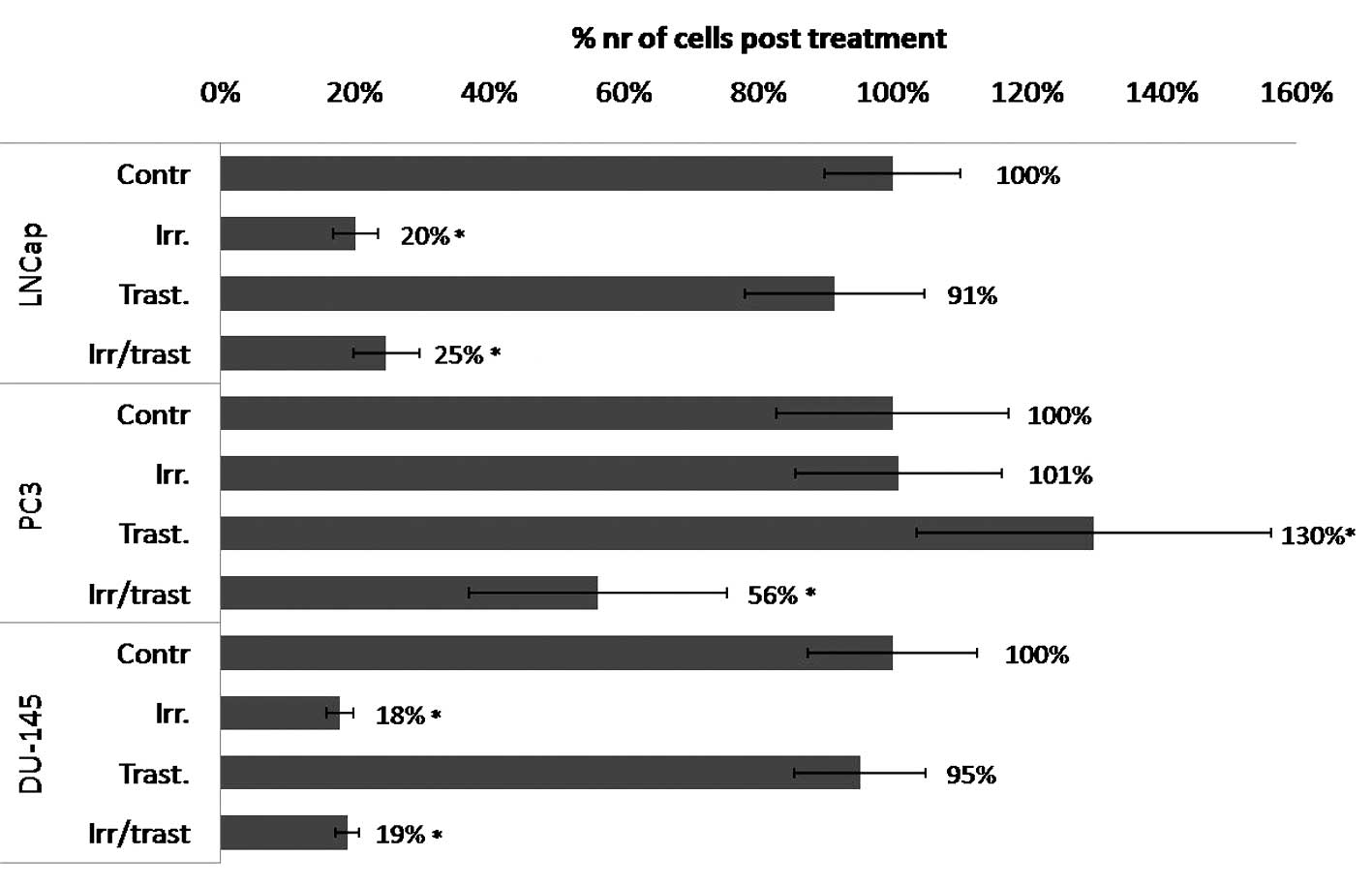|
1
|
Chen W, Mao K, Liu Z and Dinh-Xuan AT: The
role of the RhoA/Rho kinase pathway in angiogenesis and its
potential value in prostate cancer (Review). Oncol Lett.
8:1907–1911. 2014.PubMed/NCBI
|
|
2
|
Sieh W, Lichtensztajn DY, Nelson DO, et
al: Treatment and mortality in men with localized prostate cancer:
a population-based study in California. The Open Prost Cancer J.
6:1–9. 2013. View Article : Google Scholar
|
|
3
|
Widmark A, Klepp O, Solberg A, et al;
Scandinavian Prostate Cancer Group Study 7; Swedish Association for
Urological Oncology. Endocrine treatment, with or without
radiotherapy, in locally advanced prostate cancer (SPCG-7/SFUO-3):
an open randomised phase III trial. Lancet. 373:301–308. 2009.
View Article : Google Scholar
|
|
4
|
Pienta KJ and Bradley D: Mechanisms
underlying the development of androgen-independent prostate cancer.
Clin Cancer Res. 12:1665–1671. 2006. View Article : Google Scholar : PubMed/NCBI
|
|
5
|
Harmenberg U, Hamdy FC, Widmark A,
Lennernäs B and Nilsson S: Curative radiation therapy in prostate
cancer. Acta Oncol. 50-1:98–103. 2011. View Article : Google Scholar
|
|
6
|
Kelloff GJ, Choyke P and Coffey DS:
Prostate Cancer Imaging Working Group: Challenges in clinical
prostate cancer: role of imaging. Am J Roentgenol. 192:1455–1470.
2009. View Article : Google Scholar
|
|
7
|
Petrylak DP, Tangen CM, Hussain MH, et al:
Docetaxel and estramustine compared with mitoxantrone and
prednisone for advanced refractory prostate cancer. N Engl J Med.
351:1513–1520. 2004. View Article : Google Scholar : PubMed/NCBI
|
|
8
|
Minner S, Jessen B, Stiedenroth L, et al:
Low level HER2 overexpression is associated with rapid tumor cell
proliferation and poor prognosis in prostate cancer. Clin Cancer
Res. 16:1553–1560. 2010. View Article : Google Scholar : PubMed/NCBI
|
|
9
|
Yarden Y and Sliwkowski MX: Untangling the
ErbB signalling network. Nat Rev Mol Cell Biol. 2:127–137. 2001.
View Article : Google Scholar : PubMed/NCBI
|
|
10
|
Signoretti S, Montironi R, Manola J, et
al: Her-2-neu expression and progression toward androgen
independence in human prostate cancer. J Natl Cancer Inst.
92:1918–1925. 2000. View Article : Google Scholar : PubMed/NCBI
|
|
11
|
Craft N, Shostak Y, Carey M and Sawyers
CL: A mechanism for hormone-independent prostate cancer through
modulation of androgen receptor signaling by the HER-2/neu tyrosine
kinase. Nat Med. 5:280–285. 1999. View
Article : Google Scholar : PubMed/NCBI
|
|
12
|
Culig Z, Hobisch A, Cronauer MV, et al:
Androgen receptor activation in prostatic tumor cell lines by
insulin-like growth factor-I, keratinocyte growth factor, and
epidermal growth factor. Cancer Res. 54:5474–5478. 1994.PubMed/NCBI
|
|
13
|
Valerie K, Yacoub A, Hagan MP, Curiel DT,
Fisher PB, Grant S and Dent P: Radiation induced cell signaling:
inside-out and outside-in. Mol Cancer Ther. 6:789–801. 2007.
View Article : Google Scholar : PubMed/NCBI
|
|
14
|
So A, Gleave M, Hurtado-Col A and Nelson
C: Mechanisms of the development of androgen independence in
prostate cancer. World J Urol. 23:1–9. 2005. View Article : Google Scholar : PubMed/NCBI
|
|
15
|
The US National Institutes of Health.
Paclitaxel and radiation therapy with or without trastuzumab in
treating patients who have undergone surgery for bladder cancer.
NCT00238420. 2014, ClinicalTrials.govurisimpleClinicalTrials.gov.
|
|
16
|
The U.S National Institutes of Health.
Evaluation of carboplatin/paclitaxel with and without trastuzumab
(Herceptin) in uterine serous cancer. NCT01367002. 2014, ClinicalTrials.govurisimpleClinicalTrials.gov.
|
|
17
|
The U.S National Institutes of Health.
Safety study of 212Pb-TCMC-trastuzumab radio
immunotherapy. NCT01384253. 2014, ClinicalTrials.govurisimpleClinicalTrials.gov.
|
|
18
|
Albanell J, Codony J, Rovira A, Mellado B
and Gascón P: Mechanism of action of anti-HER2 monoclonal
antibodies: scientific update on trastuzumab and 2C4. Adv Exp Med
Biol. 532:253–268. 2003. View Article : Google Scholar : PubMed/NCBI
|
|
19
|
Malmberg J, Tolmachev V and Orlova A:
Imaging agents for in vivo molecular profiling of disseminated
prostate cancer: Cellular processing of [(111)In]-labeled
CHX-A″DTPA-trastuzumab and anti-HER2 ABY-025 Affibody in prostate
cancer cell lines. Exp Ther Med. 2:523–528. 2011.PubMed/NCBI
|
|
20
|
Ahlgren S, Orlova A, Wållberg H, et al:
Targeting of HER2-expressing tumors using 111In-ABY-025, a
second-generation affibody molecule with a fundamentally
reengineered scaffold. J Nucl Med. 51:1131–1138. 2010. View Article : Google Scholar : PubMed/NCBI
|
|
21
|
Malmberg J, Tolmachev V and Orlova A:
Imaging agents for in vivo molecular profiling of disseminated
prostate cancer targeting EGFR receptors in prostate cancer:
comparison of cellular processing of [111In]-labeled affibody
molecule Z (EGFR:2377) and cetuximab. Int J Oncol. 41:1128–1138.
2011.
|
|
22
|
Baek KH, Hong ME, Jung YY, et al:
Correlation of AR, EGFR, and HER2 Expression Levels in Prostate
Cancer: Immunohistochemical Analysis and Chromogenic In Situ
Hybridization. Cancer Res Treat. 44:50–56. 2012. View Article : Google Scholar : PubMed/NCBI
|
|
23
|
Carrion Salip D, Panosa C, Menendez JA, et
al: Androgen-independent prostate cancer cells circumvent EGFR
inhibition by overexpression of alternative HER receptors and
ligands. Int J Oncol. 41:1128–1138. 2012.PubMed/NCBI
|
|
24
|
Malmberg J, Perols A, Varasteh Z, et al:
Comparative evaluation of synthetic anti-HER2 Affibody molecules
site-specifically labelled with 111In using N-terminal DOTA, NOTA
and NODAGA chelators in mice bearing prostate cancer xenografts.
Eur J Nucl Med Mol Imaging. 39:481–492. 2012. View Article : Google Scholar : PubMed/NCBI
|
|
25
|
Wallberg H, Orlova A, Altai M, et al:
Molecular design and optimization of 99mTc-labeled recombinant
affibody molecules improves their biodistribution and imaging
properties. J Nucl Med. 52:461–469. 2011. View Article : Google Scholar : PubMed/NCBI
|
|
26
|
Duru N, Fan M, Candas D, et al:
HER2-associated radioresistance of breast cancer stem cells
isolated from HER2-negative breast cancer cells. Clin Cancer Res.
18:6634–6647. 2012. View Article : Google Scholar : PubMed/NCBI
|
|
27
|
No M, Cho EJ and Kim IA: Targeting HER2
signaling pathway for radiosensitization: alternative strategy for
therapeutic resistance. Cancer Biol Ther. 8:2351–2361. 2009.
View Article : Google Scholar : PubMed/NCBI
|












